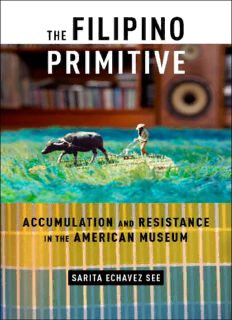
The Filipino Primitive: Accumulation and Resistance in the American Museum PDF
Preview The Filipino Primitive: Accumulation and Resistance in the American Museum
The Filipino Primitive The Filipino Primitive Accumulation and Resistance in the American Museum Sarita Echavez See NEW Y ORK UNIVERS ITY P RESS New York NEW YORK UNIVERSITY PRESS New York www.nyupress.org © 2017 by New York University All rights reserved References to Internet websites (URLs) were accurate at the time of writing. Neither the author nor New York University Press is responsible for URLs that may have expired or changed since the manuscript was prepared. ISBN: 978-1-4798-4266-7 (hardback) ISBN: 978-1-4798-2505-9 (paperback) For Library of Congress Cataloging-in-Publication data, please contact the Library of Congress. New York University Press books are printed on acid- free paper, and their binding materials are chosen for strength and durability. We strive to use environmentally responsible suppli- ers and materials to the greatest extent possible in publishing our books. Manufactured in the United States of America 10 9 8 7 6 5 4 3 2 1 Also available as an ebook Contents Acknowledgments vii Introduction: Accumulating the Primitive 1 Part I. The Ar chive: Dispossession by A ccumulation 1. Progress through the Museum: Knowledge Nullius and the University of Michigan Museum of Natural History 25 2. Foreign in a Domestic Space: Progressivist Imperialism and the Frank Murphy Memorial Museum 55 Part II. The R epertoire of Dispossession 3. Lessons from the Illiterate: Carlos Bulosan and the Staged Wages of Romance 99 4. The Booty and Beauty of Contemporary Filipino/American Art: Stephanie Syjuco’s RAIDERS 141 Conclusion: Accumulation Now and Then 171 Notes 189 Bibliography 211 Index 225 About the Author 237 v Acknowledgments I am indebted to Stephanie Syjuco, Lonnie Carter, and Ma- Yi Theater Company, especially Ralph Peña and Jorge Ortell, for their brilliant work, and I thank them for their kind forbearance as I have tried to do justice to their creations. For their generosity in spirit and time, I am grateful to the staff at the University of Michigan Museum of Natural History, especially John Klausmeyer and Amy Harris; and the staff at the Frank Murphy Memorial Museum, especially Barb MacGowan and Bobbie Ramsey. I thank the Dean’s Office of the College of Humani- ties, Arts, and Social Sciences at the University of California Riverside for a timely grant that helped to fund book production. Special thanks to Joshua Sung, Jason Corañez Bolton, Dakota Lindsi Tu, and Alex Ratanapratum for their research assistance; Mark Gjukich, Matt Zugale, and Lynda Fitzgibbon for permission to reproduce their photography; Bradley Cardozo and the other members of the Ethnography As Activ- ism Subgroup on Repatriation at the University of Michigan for their insistence on the merging of politics and research; and my colleagues in Media and Cultural Studies at U.C. Riverside, who make the day job a joyous challenge. Eric Zinner helped me see that there was indeed a there there before I could discern anything. Fred Moten, Bakirathi Mani, Lucy Burns, Karen Tongson, Thea Tagle, Alexandra Dalferro, and Chairat Polmuk kindly invited me to give talks at their respective campuses that helped me to de- velop the book. Paula Chakravartty, Denise da Silva, and Lorenzo Vera- cini provided excellent editorial feedback on earlier essay versions. Allan Isaac and again Denise da Silva provided feedback both generous and sharp at a later critical stage. Clare Counihan’s editorial acumen is won- drous and frightening and helped the chapters take on shape in ways that allowed me to despair less. I have the finest of writing companions, those who continue to believe in the importance and even primacy of talking about rather than merely reading one another’s work: Marie Lo, vii viii | Acknowledgments Sadia Abbas, David Lloyd, Kimberly Alidio, Nadine Naber, Jodi Kim, Karlyn Koh, and Christine So; the “Hangouts” Faye Chen, Anthony Ocampo, and Jason Magobo Perez; the FSP gang Lorena Llosa, Nico- las Zegre, Hall Bjornstad, and Joy Gayles; and the PTF gang of women professors at U.C. Riverside. Alan Krohn talked me into doing the writ- ing. And Hiram Pérez has helped me keep hope alive all these years we’ve known each other by refusing to discuss the writing. For their love and support throughout, I am profoundly grateful to my parents, Ani- cia Echavez See and See Chak Mun, and my brother and sister- in- law, Gerald and Amy See. David Lloyd does it all— reads the writing, talks about the writing, doesn’t talk about the writing, walks away from the writing— and it is my luck to be able to learn daily from him how to give, so thoughtfully and unthinkingly. Introduction Accumulating the Primitive They must be soldiers or militiamen. They are armed white men. They must be readying themselves for frontier war or at the very least a skirmish with dangerous savages. But they are not soldiers. They are scientists. This is a portrait of a professor encircled by his students. In the 1870s the amateur naturalist Joseph Beal Steere left his home in Michigan and embarked on a circumglobal expedition that included the Philippines and that resulted in a donation of sixty thousand specimens— botanical, zoological, and anthropological— to his alma mater, the University of Michigan. This massive donation prompted the university to award Steere its first honorary doctorate and to build its first natural history museum building. In 1887, the year of this portrait Figure I.1. Photograph displayed in the Philippine exhibit at the University of Michigan Museum of Natural History, Ann Arbor. Photograph by Mark Gjukich. 1
Description: